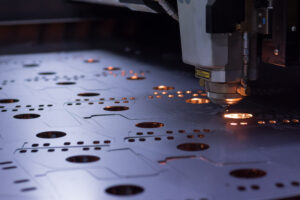Intro
A sheet metal prototype needs to be delivered quickly so you can start testing it, iterating the design, and moving closer to final production. The good news? There are some quick ways to speed up the whole prototype fabrication process.
Our experts put together this list of 6 tips for faster sheet metal prototypes. These tips will help you get functional sheet metal prototypes delivered to your door even faster. Let’s get started.
Use the Right Fabrication Method
The whole success of the project revolves around using the right fabrication method. For sheet metal, you can consider CNC machining, laser cutting, waterjet cutting, drilling, bending, using hand tools, and plenty of post-processing options.
Why does this matter? You should know which fabrication method you want to use so you can correctly make your 2D drawings. A 2D drawing with no dimensions on it can’t be turned into a CNC-machined part, and certain features are impossible to make on a laser cutter.
As an engineer or designer, you should design your part with the final fabrication method in mind.
Triple-Check Your CAD Model
We’ve had to make countless phone calls over the years simply due to CAD models that were incomplete or incorrect. It’s not the end of the world (and we know that mistakes happen, so it’s not a huge deal), but it will delay your project.
Things get even more delayed if it’s hard to get in touch with you. It’s best to avoid the situation altogether by going through your CAD model a few times. Triple-check your dimensions, layouts, the fitment, and ensure all of your design constraints are met.
If your CAD model has some dimensions that are wrong, the machinist will make the part and send you something that won’t work. This isn’t the machine shop’s fault, and it will lead to a lot of delays and wasted money.
Understand the Machine’s Limits
Another part of understanding what machine will be used to fabricate your sheet metal part is understanding the limits of the machine. If a waterjet cutting machine can only handle parts up to 174” x 30”, there’s no way you can make a 150” x 150” part.
This is an extreme example, but it gets the point across — you need to know what the machine can and can’t do.
Simplify Your Design
Another huge issue that leads to delays traces back to your design. If the design is too complicated and has a lot of features that aren’t needed, it will take a machine shop much longer to make it and send it over.
Our advice is to use stock material, standard sizing, and nominal dimensions across the board. If every design sticks to these three suggestions, you’ll have noticeably simpler designs.
Another element to consider is whether the design feature you added is a “want” or a “need”. If it’s a “want”, then you need to evaluate the cost of adding that feature versus the benefit of having the feature. If it costs another $500 in machining and only boosts the aesthetics of the part, is it worth it?
If the feature is a “need”, then there’s no avoiding it. All you can do is try to simply the surrounding parts as much as possible to keep the cost and turnaround time lower for this part.
In theory, the idea of simplifying a design is really easy. In practice, it’s a lot harder. You can always bounce ideas off of our machinists if you’re not sure.
Learn from Expert Machinists
Speaking of, there are a lot of valuable things that you can learn from an expert machinist. A good machinist can give you design tips and teach you about the limitations of certain machines.
Ideally, every design engineer should do a short rotation in a machine shop to learn more about the fabrication side of things. It will help your designs a lot.
Think of it this way — you can draw any shape you want on your screen, but how will you make it? Knowing more about machining will help you get faster sheet metal prototypes.
Start With the Right Machine Shop
The right machine shop will offer great turnaround times while still delivering high-quality parts. We should suggest avoiding shops that solely focus on discounts and keeping the prices incredibly low.
It’s worth paying a little extra for high-quality sheet metal prototypes, as long as you’re not grossly overpaying for the service.
Ask about turnaround times during the quotation process. Also, choose a machine shop that has plenty of different fabrication equipment. If they offer CNC machining, waterjet cutting, and laser cutting, you’ll enjoy even faster turnarounds.
Conclusion
Now you have a few ways to speed up the prototyping process for your next sheet metal project. Remember the fabricator’s limits, check your CAD model, and keep everything simple to breeze through this process.
If you want faster results, you can trust our team at Rapid Axis. We are a full-service machine shop with dozens of fabrication machines in-house. Reach out to us for your next sheet metal prototyping project and enjoy even quicker turnarounds. Get a free quote today.
